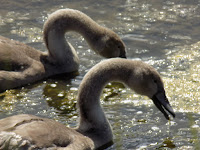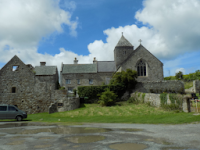We came across
the Conwy reserve last year, having picked up the signposts for it while coming through Llandudno Junction. Unfortunately, at that time we arrived just before closing time and so didn't get to see more than a peek of the
Conwy Estuary, from the car park.
You enter the reserve through a wooden cabin which, besides housing the tills, contains a more upmarket selection of souvenirs, as well as a selection of binoculars and such like, wild-life books and leaflets and a good selection of wild bird food. There's also a cafe and toilets here, as well as an area for the kids to have a run around. This first bit is free and consequently quite busy. To get out into the reserve, you have to pay (consider it a donation).
This is a reserve designed to attract a variety of wild-life, not just birds, as obviously birds are dependent on flowers and insects etc for their existence, and the presence of so many birds, in turn, attracts other wild-life.

There were a lot of butterflies, including the
red burnet, which some people were confusing with the
cinnabar moth, which is a similar colour.
There is a lot to please botanists, as to attract butterflies, a lot of wild plants are being encouraged to grow, including ragwort so beloved of the cinnabar moth, and so disliked by land owners because it's poisonous to horses.

The reserve is accessed by following a number of sign posted, firm pathways, most of which are suitable for wheel chairs and prams.
There are hides at the end of most of these pathways, with viewing holes set at different heights, and a stepped stool is available for the vertically challenged to stand on (the site encourages children).

There is, obviously, walking to be done, though mostly on firm, level ground, and at the end of the day, you can walk as much as you want. Or not, as the case may be.

Typical estuary birds are egret, heron, moorhen, coot,
duck and
swan, as well as gull, lapwing, godwit and water rail.
Watch out for the robins. A fair few of them are very tame- though it could have been the same robin following us around.

If you look across the estuary, you will see
Conwy Castle in all its glory. If you finish early enough at the reserve, go and visit Conwy itself and, if you can afford it, the castle. It's worth the effort.
And let us not forget the mountains on the other side of the river, which make this place so,so special.






